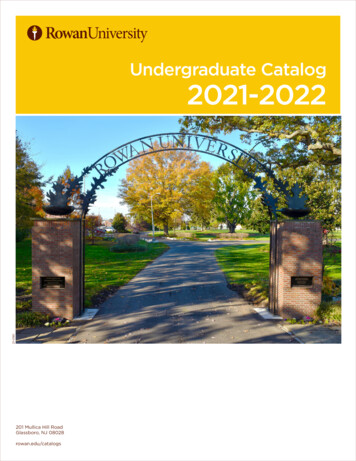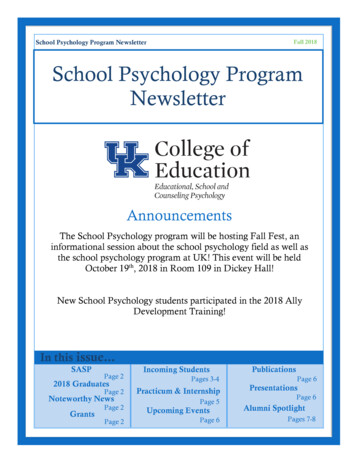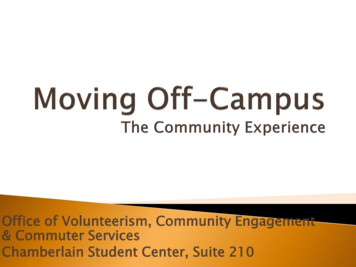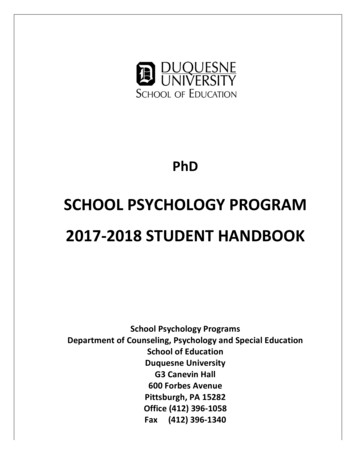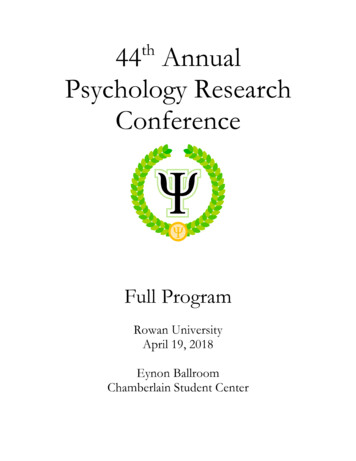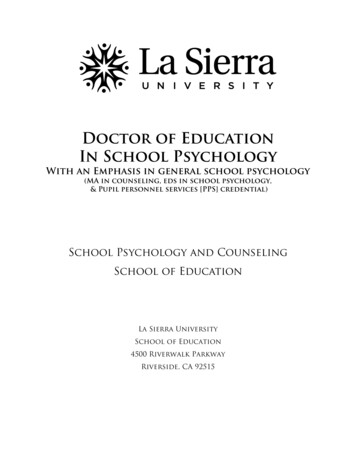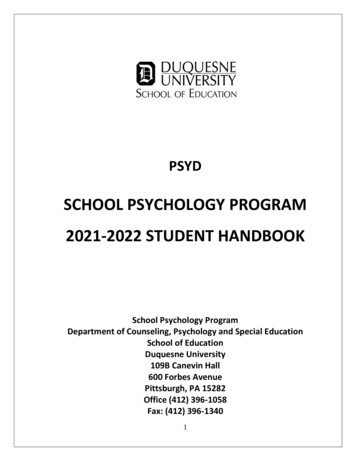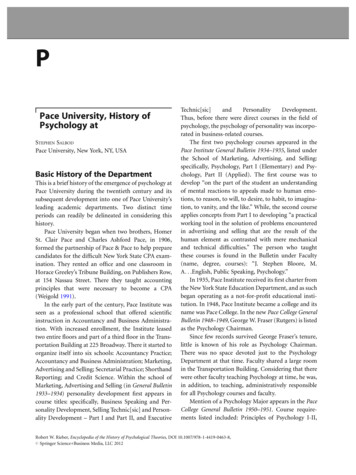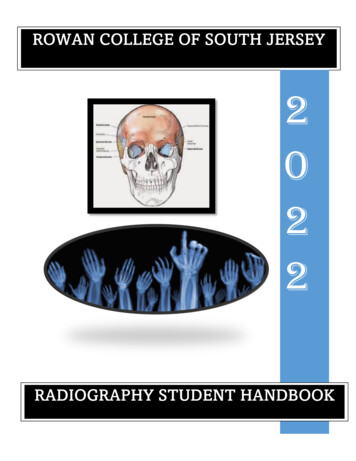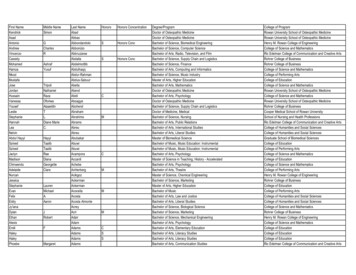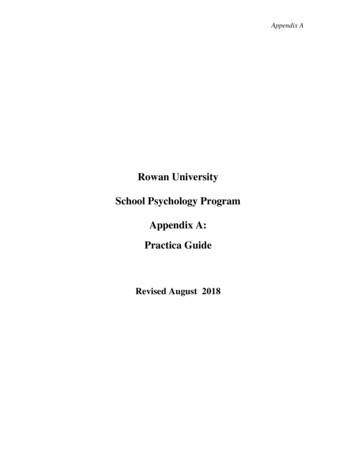
Transcription
Appendix ARowan UniversitySchool Psychology ProgramAppendix A:Practica GuideRevised August 2018
Table of ContentsPageIntroduction3Description3Practicum Contract5Guidelines for Practicum Logs8Practicum Evaluation RubricsEvaluation of Psychological or Psychoeducational ReportLinked to Intervention9Academic or Social/Behavioral Assessment forIntervention Evaluation Rubric11Problem-Solving Consultation Evaluation16Brief Experimental Analysis17Evaluation of System Wide Intervention or ProfessionalDevelopment/In-service Presentation18Evaluation of Counseling Case19School Psychology Field Experience Evaluation for Practicum20Evaluation of Professional Work Characteristics by Faculty312
IntroductionPractica experiences are designed to provide students with opportunities topractice skills in all areas of school psychology services while under the directsupervision of a credentialed school psychologist. Integration and application of the fullrange of competencies and domains of training are expected to occur during practica andcontinue into internship.The Rowan School Psychology Program emphasizes the integration of didactictraining and field experience under close supervision. During the final semester of theMA portion of the program, students complete a 20-hour “shadowing” experience of aschool psychologist in the public schools. During the second year, students practice theirskills in areas of psychoeducational assessment, behavioral assessment and intervention,counseling, and consultation while enrolled in Educational Specialist-level courses.Finally, during the second semester of the Educational Specialist program, studentscomplete a 300-hour practicum experience under the close supervision of a schoolpsychologist.DescriptionStudents in the Rowan University School Psychology Program complete a practicumexperience as follows:A 300-hour practicum during SPSY 22630 Practicum in School Psychologyfor 3 semester credits during the final semester prior to internship.300-Hour Practicum during SPSY 22630 Practicum in School PsychologyDuring the Practicum experience, school psychology students must:1. Maintain a log of activities2. Be evaluated by their field-based supervisor using the Rowan UniversityPracticum Evaluation form that includes evaluation on professional workcharacteristics.3. Complete Practicum requirements listed below and be evaluated by theirRowan University practicum supervisor in each area:a. Psychological Evaluationb. Psychoeducational Evaluationc. Consultation Case Studyd. Academic Assessment for Interventione. Social/Behavioral Assessment for Interventionf. Systems-Wide (Universal Level) Intervention or Inserviceg. Counseling CaseThese products listed above are completed during SPSY 22630 Practicum in SchoolPsychology and compiled into a practicum portfolio to show efforts, progress andachievement in these specified areas. The practicum portfolio provides opportunities toconnect field and graduate classroom experiences. In addition, students’ knowledge,3
skills, and professional work characteristics are evaluated by their field supervisor usingthe practicum/internship evaluation instrument that assesses all ten of the NASP Domainsof Practice. The university supervisor also evaluates the student progress during the 300hour practicum.Documents to be Included in Practicum Portfolio1. Practicum Log3c. Academic Assessment for Intervention2. Practicum Evaluation completed by Field3d. Social/Behavioral Assessment for InterventionBased Supervision3e. Systems Wide (Universal Level) Intervention or3a. Psychological and Psychoeducational EvalInservice3b. Consultation Case Study3f. Counseling Case3g. Practicum ContractSummary of Practicum Assignments Related to NASP Domains3a3b3c3d3e3f12AssignmentsPsych/Psychoed EvaluationConsultation Case StudyAcademic Assessment forInterventionSocial/Behavioral Assessmentfor InterventionSystem Wide Intervention orInserviceCounseling CasePracticum LogPracticum Evaluation by 4X9XXXX8XXXXXXXXXX10XXXXXXX
ROWAN UNIVERSITY SCHOOL PSYCHOLOGY PROGRAMPRACTICUM CONTRACTThe Rowan University School Psychology Program hereby enters into an agreement with(a practicum student in school psychology), and(the local education unit), pursuantto a school psychology practicum. The period of appointment is from to(dates).The Practicum in School Psychology: Is distinct from, precedes and prepares the school psychology graduate student forthe school psychology internship,Consists of a minimum of 300 hours,Fosters the candidate skill and competency development,Requires activities and systematic development and evaluation of skills that areconsistent with the goals of the Rowan University School Psychology Program andemphasizes human diversity.The purpose of this agreement is to set forth the conditions of the practicum and to clarifythe responsibilities of the parties to this agreement.Practicum Student in School Psychology1.The Practicum in School Psychology is completed for academic credit throughenrollment in SPSY 22630 Practicum in School Psychology at Rowan University.2.The practicum student is responsible for notifying the university supervisor of anyconcerns regarding the practicum that cannot be resolved in the placement setting.3.The practicum student keeps a daily log of activities, totaling a minimum of 300hours. The practicum field supervisor signs the log to verify the number of completedhours.4.The practicum student works with the psychological services staff, schoolpersonnel, students and families in activities that are consistent with school and districtpolicies and consistent with practicum requirements.5.The practicum student will attend regularly-scheduled, on-campus, practicumseminars conducted by university faculty.5
Field Supervisor1.The supervisor must be an appropriately credentialed school psychologist in thestate in which the training experience is offered.2.The supervisor must have appropriate experience as a school psychologist3.The field supervisor will sign the practicum student’s log to verify the number ofcompleted hours.4.No more than two supervisors will provide supervision for the practicum student atany given time.5.The supervisor will meet with the practicum student during school time. A schedulefor these meetings will be developed by the supervisor and practicum.6.The supervisor has the responsibility of expeditiously notifying the universitysupervisor of any concerns about the practicum student’s performance that cannot beresolved in the placement setting.7.The supervisor will submit a final evaluation of the school psychology’s practicumstudent’s performance to Rowan University, School Psychology Program.School District1.The school district will provide a schedule of appointments, a safe and secure workenvironment, adequate office space that ensures confidentiality for consultation andassessment, and support services consistent with that afforded agency schoolpsychologists.2.The school district will provide a lockable cabinet or other secure place for keepingconfidential information.3.The school district will provide all necessary assessment and intervention materials,including test scoring and report preparation resources comparable to those provided forcertified school psychologists in the district.4.The school district will enable the practicum student to meet practicum-trainingrequirements including completion of portfolio requirements, release time for practicumsupervision, attendance at out-of-district meetings and participation in appropriatecontinuing professional development activities.6.The school district will commit to providing the practicum with a diversifiedtraining experience.6
Rowan University1.The Rowan University faculty supervisor will provide direct oversight of thepracticum to ensure appropriateness of the placement, activities, supervision, andcollaboration with the placement sites and practicum supervisors.2.The Rowan University faculty supervisor will provide close supervision ofcandidates and qualified practicum supervisors, including appropriate performance-basedevaluation, to ensure that candidates are developing professional work characteristics anddesignated competencies.3.The Rowan University faculty supervisor will make periodic on-site visits duringthe practicum experience. Visits will be scheduled on a routine basis with additionalvisits upon request from the practicum student or field supervisor.4.The Rowan University faculty supervisor will assist the practicum student and thefield supervisor in problem solving when the practicum student or the field supervisorreports an unresolved issue.5.The Rowan University faculty supervisor is responsible for assigning Practicum inSchool Psychology grades.It is understood and agreed that the parties to this arrangement may revise or modify thisagreement or the written plan for the field experience by written amendment upon mutualagreement to such amendments.This agreement shall be effective when executed by all parties.By: School Psychology Program University SupervisorDate:By: Field- Based SupervisorDate:By: School Psychology Practicum StudentDate7
Guidelines for Practicum LogsPracticum logs are completed to demonstrate the amount and diversity of the schoolpsychology student’s practicum experience. Logs should be completed for each day ofthe practicum experience and record professional activities that occur during each day.Time spent at home writing reports can be included in the logs, within reason. Practicumstudents should consult with their university supervisor if time spent outside the schoolday exceeds normal expectations. The objective of the practicum experience is for theschool psychology student to engage in diverse roles during the school day.Logs should total a minimum of 300 hours and are to be signed by the practicum studentprior to including them in the practicum portfolio. Students are encouraged to maintaintheir logs as a word processing or spread sheet document. A sample Excel file is availableas an example. See basic information required below, but use of an Excel file to recordthis information is required.School Psychology Practicum LogSample Practicum vision(Hours,specifygroup orindividual)Meetings orprofessionaldevelopment(hours anddescription)Other(pleasespecify typeof activity)SummaryofActivities:ContactHours:Rowan University School Psychology Program Coordinator will provide practicumstudents with a sample Microsoft Excel file to help organize and summarize theirdaily/weekly/total number of hours. Record all activities to the nearest quarter hour usingdecimals, e.g., 15 min. .25; 45 min. .75. Identify student by first name only. Use aone or two-word description of activity (e.g., cognitive assessment, observation. recordreview, parent interview, etc.).A summary page of the total number of hours is required in the Excel file. This summarywill be transformed into a graphic representation (pie graph) to represent the breakdownof the total 300 hours into various categories.8
Rubrics and Criteria Used to Evaluate Activities during PracticumOn the following pages are the rubrics and criteria used to evaluate activities duringPracticum.EVALUATION RUBRIC FOR PSYCHOLOGICAL ANDPSYCHOEDUCATIONAL REPORT LINKED TO INTERVENTIONExaminer:Date:Examinee:Rater:Area Assessed:Reason for referral presents a clear guide for theevaluation. Referral questions offered.Comments:Level of Competence: Beginning 1 Adequate 2 Advanced 32.Background information presents a thorough pictureof the student and sets up a foundation forunderstanding his or her strengths and needs.Comments: Beginning 1 Adequate 2 Advanced 33.Observations are written clearly and in observableterms.Comments: Beginning 1 Adequate 2 Advanced 34.Interpretations of test scores are reasonable andaccurate, and explain the individual’s functioning ona given instrument.Comments: Beginning 1 Adequate 2 Advanced 35.Interpretation of tests scores include discussion ofnormative performance (e.g., Scaled Scores, StandardScores, t-Scores, Percentile Ranks), as well as taskand process analysis.Comments: Beginning 1 Adequate 2 Advanced 36.Interpretations of test scores are reasonable andaccurate, and explain the individual’s functioning andbehaviors on a given task.Comments: Beginning 1 Adequate 2 Advanced 37.Interpretations of test scores are free of psychometricinaccuracies and/or conceptual misunderstandings.Comments: Beginning 1 Adequate 2 Advanced 38.Scores from standardized tests are tabledappropriately and located in a single table for easyreference.Comments: Beginning 1 Adequate 2 Advanced 31.9
9.Conclusions provide the essential informationregarding the student, avoids introducing new data,and offers a summary of strengths and needs.Comments: Beginning 1 Adequate 2 Advanced 310.Conclusion answers the referral questions oraddresses the reason for referral and guidesinterventions offered.Comments: Beginning 1 Adequate 2 Advanced 310.Report functions as a problem-solving assessmentlinking recommendations to interventions.Comments: Beginning 1 Adequate 2 Advanced 311.Recommendations are realistic and consistent withevaluation findings, and can be understood by thereader.Comments: Beginning 1 Adequate 2 Advanced 312.Report is readable, absent of jargon, consistent, andeasy to understand.Comments: Beginning 1 Adequate 2 Advanced 313.Report is organized, logical, meaningful, andappropriate in length.Comments: Beginning 1 Adequate 2 Advanced 314.Content is free of typographical errors andmisspellings.Comments: Beginning 1 Adequate 2 Advanced 315.Grammar and sentence structure are appropriate.Comments: Beginning 1 Adequate 2 Advanced 316.Report is signed and dated. Yes NoOverall Rating of the Report:Beginning 1Sections are only ratedBeginningAdequate 2The majority of sectionsof the case study arerated AdequateRater’s SignatureDate10Advanced 3All components in theAdequate and Advancedcategories are checked
Social/Behavioral Assessment for Intervention Evaluation RubricName:Date:Section 1: Problem IdentificationNeeds Improvement 1Effective 2Very Effective 31.1The student'sdemographic informationis provided.The student's relevantdemographic information andbackground history are provided.The student's relevantdemographic and backgroundinformation are provided utilizingmultiple sources (record review,teacher/ parent/ studentinterviews, direct observations,and assessment tools).1.2The target behavior is notcollaboratively defined.The target behavior iscollaboratively defined.The target behavior iscollaboratively defined andincludes the student's relevantskills and deficits related to thetarget behavior.1.3The student's targetbehavior is identified butnot operationally definedThe student's target behavior isoperationally definedThe student's target behavior isoperationally defined in thecontext of appropriate gradeand/or peer expectations, e.g.,local normsRating for Section 1: Problem IdentificationNeeds Improvement: Somecomponents in the Needs Improvementcategory are checkedEffective: The majority of componentsin the Effective category are checked11Very Effective: All componentsin the Very Effective and Effectivecategories are checked
Section 2: Problem Analysis:Needs Improvement 1Effective 2Very Effective 32.1Previous interventions forthe target behavior andexisting class-wide and/orschool-wide behavioralintervention strategies arenot provided.Behavioral interventionstrategies previously used toaddress the target behavior areprovided.2.2A baseline for the studentbehavior is not establishednor has insufficient data.A baseline for the studentbehavior is established.A baseline for the student behavioris established using multiplesources of data collection. Baselineincludes peer/grade norms andexpectations.2.3A hypothesis is notproposed as to thefunction of the targetbehavior.A hypothesis is proposed as tothe function of the targetbehavior.A hypothesis is proposed as to thefunction of the target behaviorbased on a functional behavioralassessment that includes directobservation, student/teacher/parentinterviews, and objectiveassessment tool.Previous interventions and classwide intervention strategies areassessed including:- student collaboration on class rules- student understanding of class rules- teacher expectations of studentconduct- efficacy of current classroommanagement strategies foraddressing the target behavior.Rating for Section 2: Problem AnalysisNeeds Improvement: Somecomponents in the Needs Improvementcategory are checkedEffective: The majority of componentsin the Effective category are checked12Very Effective: All componentsin the Very Effective and Effectivecategories are checked
Section 3: Intervention / Implementation:Needs Improvement 1Effective 2Very Effective 33.1Intervention strategies toaddress the target behaviorare provided.Intervention strategies toaddress the target behavior areoperationally defined anddescribed in relation to thefunctional behavioralassessment.Interventions are operationallydefined, linked to the functionalbehavioral assessment, anddeveloped collaboratively withteachers, parents and others toensure sensitivity to individualdifferences, resources, classroompractices, and other system issues.3.2Intervention strategies arenot evidence-based.Intervention strategies areevidence-based and supportedby current research.Appropriate research is cited tosupport intervention strategyselections.3.3Behavioral goals andprogress monitoringstrategies are not provided.Behavioral goals and basisprogress monitoring strategiesare provided.Behavioral goals are logicallylinked to the referral question andwritten in observable, measurableterms. Progress monitoring datacollection procedures include:- who collects the data- how the data is collected- how often the data is collected3.4A plan for theimplementation ofintervention strategies is notprovided.Implementation plan includesat least two of the following:Implementation plan includesall of the following:- who implements strategies- where are strategies implemented- frequency of implementation- conditions for not implementingstrategies- plans to monitor, review andrevise implementation- who implements strategies- where are strategies implemented- frequency of implementation- conditions for not implementingstrategies- plans to monitor, review andrevise implementationRating for Section 3: Intervention ImplementationNeeds Improvement: Somecomponents in the Needs Improvementcategory are checkedEffective: The majority of componentsin the Effective category are checked13Very Effective: All componentsin the Very Effective and Effectivecategories are checked
Section 4: Evaluation:Needs Improvement 1Effective 2Very Effective 34.1Progress monitoring dataare not demonstrated on achart.Progress monitoring data aredemonstrated on a chart.Charting includes studentperformance trend lines, and/orgoal lines. Current technologieswere used to present data.4.2Intervention is notdemonstrated to beeffective through datacomparison.Progress monitoring data aredemonstrated to be effectivewhen compared to baselinedata.Progress monitoring data aredemonstrated to be effectivewhen compared to datagenerated from multiplesources/settings.4.3Strategies fortransfer/generalizingoutcomes to other settings arenot addressed.Strategies for transfer/generalizing outcomes to othersettings are addressed.Strategies for transfer/generalizing outcomes to othersettings are documented aseffective.4.4Effectiveness ofintervention is not sharedor communicated.Effectiveness of intervention isshared through collaborationwith parents, teachers, andother personnel.Modifications for futureinterventions are consideredbased upon collaborativeexamination of effectivenessdata.4.5Suggestions for follow-upare not developed.Suggestions for follow-up aredeveloped (e.g., continuedprogress monitoring,transition planning).Strategies for follow-up aredeveloped and implemented.Rating for 4: EvaluationNeeds Improvement: Somecomponents in the Needs Improvementcategory are checkedEffective: The majority of componentsin the Effective category are checked14Very Effective: All componentsin the Very Effective and Effectivecategories are checked
Overall Rating of Social/Behavioral Assessment for InterventionNeeds Improvement 1Sections are only rated NeedsImprovementEffective 2The majority of sectionsof the case study arerated EffectiveVery Effective 3All components in theVery Effective andEffective categories arecheckedComments:Case study reviewed by:Date:15
Problem-Solving Consultation Consultation ComponentsComments(Include a comment for each componentindicating a reason for rating of C, B, or N)(circle one)C: CompetentB: BasicN: NoviceI. IntroductionSchool and classroom setting aredescribed.The consultee introduced and describedthe problem.C B NYesNoYesNoYesYesYesYesNoNoNoNoC B NYesYesYesNoNoNoC B NII. Problem identificationObjectives are establishedPerformance measures are selected.Data are collected and reported.The discrepancy between current anddesired performance are determined.III. InterventionIntervention plan is developed.Intervention is implemented.Procedures to monitor and evaluateintervention success are described.IV. Implications for teaching strategiesImplications are discussed.YesNoV. Evaluation of Consultation ProcessObjective measures of consultationprocess are used.Evaluation of process is discussed.YesNoYesNoOverall Rating of ConsultationC B NC B NCommunication SkillsI. Communication SkillsThe consultant listened more thantalked.Questioning was effective.The consultant kept track of thecomments made by the consultee, andefficiently integrated, paraphrased, andsummarized the consultee's thoughtsand concerns.Appropriate affect was displayed by theconsultant through empathy andvalidation.YesNoYesNoYesNoYesNoOverall Rating ofCommunication SkillsC B NC B N16
EVALUATION RUBRIC FOR BRIEF EXEPERIMENTALANALYSIS (BEA)Examiner:Date:Area Assessed:Background includes information on the student,setting, and reason for assessment in the specificacademic area.Comments:Level of Competence: Needs Development 1 Effective 22.Experimental conditions explained.Comments: Needs Development 1 Effective 23.Baseline measures completed.Comments: Needs Development 1 Effective 24.Hypothesis 1 is stated and procedure for assessing isclearly described.Comments: Needs Development 1 Effective 25.Hypothesis 2 is stated and procedure for assessing isclearly described.Comments: Needs Development 1 Effective 26.Hypothesis 3 is stated and procedure for assessing isclearly described.Comments: Needs Development 1 Effective 27.Hypothesis 4 is stated and procedure for assessing isclearly described.Comments: Needs Development 1 Effective 28.Clear explanation of conclusionsComments: Needs Development 1 Effective 29.Data are graphed.Comments:1.Overall Rating of the Report: Needs DevelopmentRater’s Signature Needs Development 1 Effective 2 EffectiveDate17
Rowan UniversitySchool Psychology ProgramEvaluation of Systems Wide Intervention or Professional Development/In-servicePresentationIntern’s Name:School:Topic:Date Presented:NeedsImprovement1EffectiveVery Effective23123Conducts needs assessment123Plans intervention/inservice123Prepares intervention/inservice123Prepares evaluation tool123Delivers inservice usingPower Point (technology).123Conducts evaluation ofintervention/inservice123Summarizes results ofevaluation123Collaborates inbrainstorming possibleneeds for intervention/inserviceDesigns needs assessment18
Rowan UniversitySchool Psychology ProgramEvaluation of Counseling CaseIntern’s EffectiveVery Effective23Referral concerns are redefined inspecific and measureable terms.123Multi-modal analysis is used forassessment and goal setting.123Multi-modal interventions areutilized.123Progress notes/case summary areincluded.123Impact of counseling interventionon functioning of the student orgroup in school and/or at home isdocumented.123Summary includes backgroundand history that enables faculty tounderstand the case.Comments:Signature of EvaluatorDate19
Rowan UniversitySchool Psychology Practicum Evaluation*Intern Name:Supervisor:Date of Evaluation:District:To:Dates covered by this evaluation: FromPlease rate the practicum student on each of the following items:Performance AreaPerformance RatingPractices That Permeate All Aspects of Service DeliveryDomain 1: Data-Based Decision-Making and Accountability1.1.) Demonstrates knowledge of varied models and methods of assessment thatyield information useful in identifying strengths and needs, in understandingproblems and in measuring progress and accomplishments.VeryEffective(3)Effective1.2.) Demonstrates effective development and implementation of academic andbehavioral interventions that are based on data gathered from the team problemsolving (decision-making) and assessment process(es) and linked to goals andoutcomes.VeryEffective(3)Effective1.3.) Demonstrates an emerging knowledge base of problem-solving (decisionmaking) processes that are related to educational research and systems-leveland/or building level No OpportunityImprovementto Observe(1)(NO)NeedsNo OpportunityImprovementto Observe(1)(NO)NeedsNo OpportunityImprovementto Observe(1)(NO)
1.4.) Demonstrates an emerging knowledge base of problem-solving(decision-making) processes that are related to educational research andsystems-level and/or building level concerns.VeryEffective(3)Effective(2)NeedsNo OpportunityImprovementto Observe(1)(NO)Comments:Domain 2: Consultation and Collaboration2.1) Demonstrates knowledge of behavioral, mental health, collaborativeand/or other consultation models and methods.2.2) Collaborates effectively with others in planning and decision-makingprocesses at the individual, group and systems level.2.3) Communicates and collaborates effectively with school personnel.2.4) Communicates and collaborates effectively with students and 3)Effective(2)(2)(2)(2)NeedsNo OpportunityImprovementto Observe(1)(NO)NeedsNo OpportunityImprovementto Observe(1)(NO)NeedsNo OpportunityImprovementto Observe(1)(NO)NeedsNo OpportunityImprovementto Observe(1)(NO)
2.5) Collaborates effectively with others throughout the problem-solving andassessment process.VeryEffective(3)Effective(2)NeedsNo OpportunityImprovementto Observe(1)(NO)Comments:Direct and Indirect Services for Children, Families and SchoolsStudent-Level ServicesDomain 3: Interventions and Instructional Support to Develop Academic Skills3.1) Demonstrates knowledge of human learning processes, techniques toassess these processes and direct and indirect services applicable to thedevelopment of cognitive and academic skills.Very EffectiveEffective(3)(2)3.2) Demonstrates knowledge of and skills in developing effectiveinstructional strategies/intervention to promote learning of students atindividual, group or systems levels.Very EffectiveEffective(3)(2)3.3) Properly administers and interprets assessment strategies to measurecognitive abilities and academic achievement.Very EffectiveEffective(3)(2)22NeedsNo OpportunityImprovementto Observe(1)(NO)NeedsNo OpportunityImprovementto Observe(1)(NO)NeedsNo OpportunityImprovementto Observe(1)(NO)
3.4) Demonstrates skills in linking assessment data to development ofinstructional interventions.Very EffectiveEffective(3)(2)3.5) Demonstrates in collaboration and consultation with others the abilityto develop appropriate curricular or intervention strategies that areevidenced-based.Very EffectiveEffective(3)(2)3.6) Assesses treatment integrity of intervention implementation.Very EffectiveEffective(3)(2)Very EffectiveEffective(3)(2)3.7) Demonstrates ability to conduct curriculum-based, progressmonitoring or other authentic methods of assessments of academic skills.NeedsNo OpportunityImprovementto Observe(1)(NO)NeedsNo OpportunityImprovementto Observe(1)(NO)NeedsNo OpportunityImprovementto Observe(1)(NO)NeedsNo OpportunityImprovementto Observe(1)(NO)Comments:Domain 4: Interventions and Mental Health Services to Develop Social and Life Skills4.1) Properly administers, analyzes and interprets assessment strategiesto measure behavioral, affective, adaptive and social domains.23Very EffectiveEffective(3)(2)NeedsNoImprovement Opportunity(1)to Observe(NO)
4.2) Demonstrates skills in linking assessment data to development ofbehavioral interventions, including functional behavioral assessment.Very EffectiveEffective(3)(2)Very EffectiveEffective(3)(2)Very EffectiveEffective(3)(2)Very EffectiveEffective(3)(2)4.6) Demonstrates skills in providing direct interventions, i.e.,individual counseling, group counseling, applied behavior analysis,social problem solving skills.Very EffectiveEffective(3)(2)4.7) Demonstrates skills in providing indirect intervention, i.e.,collaborative consultation with teachers/support staff/parents.Very EffectiveEffective(3)(2)4.3) Utilizes ecological and behavioral approaches when developingbehavior change programs and other evidence-based interventions.4.4) Appropriately evaluates outcomes of interventions and assessestreatment integrity of intervention implementation.4.5) Utilizes intervention and progress monitoring data to guideinstructional decisions.24NeedsNoImprovement Opportunity(1)to Observe(NO)NeedsNoImprovement Opportunity(1)to Observe(NO)NeedsNoImpro
Rowan University School Psychology Program Coordinator will provide practicum students with a sample Microsoft Excel file to help organize and summarize their daily/weekly/total number of hours. Record all activities to the nearest quarter hour using decimals, e.g., 15 min. .25; 45 min. .75. Identify student by first name only.
